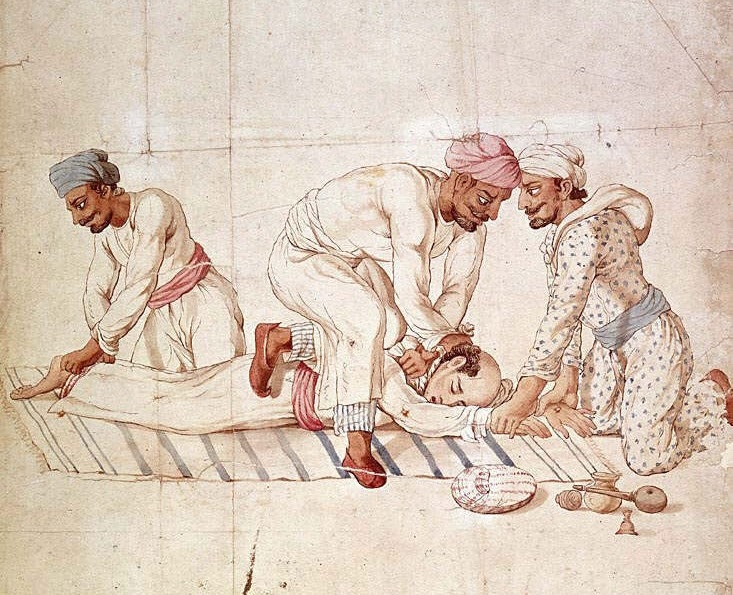Thuggog
The Thuggog (/ˈθʌɡ ɑɡ/, Törkic: Tugok [θʌˈɡɑɡ] “deceiver”) were well-organized secret fraternities of professional roving bandits and murderers, who preyed upon travelers on the Great Western Trade Road in central Heremonia for several hundred years. Drawn primarily from the Agonamic Gog and Magog tribes, they were a cult of the destructive goddess Yikim. It has been estimated that they killed and robbed as many as 3,000 traders, pilgrims and others each year during the time they were active.
At the right moment, usually when the targets were asleep, a sign would be given by the leader and the Thuggog would strangle their victims in order to steal their belongings, usually with the saffron colored silk cords they wore around their waists, and by which the discerning traveler might have identified them. The Thuggog took great pains to conceal their crimes, frequently dismembering the bodies and concealing them in wells or in deep graves.
All Thuggog were adherents to the cult of Yikim, the goddess of time, death and destruction. They believed it was their sacred duty to kill non-believers, lest Yikim destroy the entire world as punishment for their failure. Despite their efforts to maintain the secrecy of their actions, the sheer volume of their murderous activity soon revealed their existence. They were opposed by the Knights Garda, who from the eleventh through the fifteenth centuries escorted pilgrims to Sancta Cedes along the Great Western Trade Road and established fortresses along the way to care for the sick and weary.
The Thuggog were ultimately repressed and driven out of the Agnomain in the nineteenth century, although the government of Gog Chassan continues to struggle in its efforts to extend full control over its western province, where the influence of Thuggog culture continues to hold sway even today.
Etymology
Thuggog is a modern translation of tugok (“deceiver”), the Törkic name for the cult of brigands, from Agnomic tagogh (“swindler, cheat”), from Proto-Kilto-Agnomic sthok (“to cover, conceal”). The term has passed into the current vernacular, sometimes abbreviated thugg, to denote brutal behavior.History
It is unclear when the cult of Yikim originated, or when the first Thuggog bands were organized. They are first mentioned in a passage of Yildiz Öztörk’s Kral Gözde'nin Hayati (“Life of King Gözde”), published in 1045:In the fourth year of the King’s reign, some Tugok were apprehended and returned to the court, and by the persuasion of some to reveal their secrets, nearly a thousand of their kind were captured. The King gave orders that not one should be killed, but they were to be put into boats and sent across Umbagog to the lower country to dwell among the Gog, and thus be of no further trouble to the Magog.The Thuggog travelled in groups across the Central Plains north of Lake Auber, which they called Umbagog. They primarily focused their villainous activities along the Great Western Trade Road. Organized into small bands that spoke a secret language and communicated in secret signs, they would disguise themselves as travelers, and carry with them the implements needed for a long journey. They would meet their prey along the road, and slowly insinuate themselves into their company, sometimes traveling for many days together to gain the trust of their victims.
– Kral Gözde'nin Hayati
At the right moment, usually when the targets were asleep, a sign would be given by the leader and the Thuggog would strangle their victims in order to steal their belongings, usually with the saffron colored silk cords they wore around their waists, and by which the discerning traveler might have identified them. The Thuggog took great pains to conceal their crimes, frequently dismembering the bodies and concealing them in wells or in deep graves.
All Thuggog were adherents to the cult of Yikim, the goddess of time, death and destruction. They believed it was their sacred duty to kill non-believers, lest Yikim destroy the entire world as punishment for their failure. Despite their efforts to maintain the secrecy of their actions, the sheer volume of their murderous activity soon revealed their existence. They were opposed by the Knights Garda, who from the eleventh through the fifteenth centuries escorted pilgrims to Sancta Cedes along the Great Western Trade Road and established fortresses along the way to care for the sick and weary.
The Thuggog were ultimately repressed and driven out of the Agnomain in the nineteenth century, although the government of Gog Chassan continues to struggle in its efforts to extend full control over its western province, where the influence of Thuggog culture continues to hold sway even today.




Comments